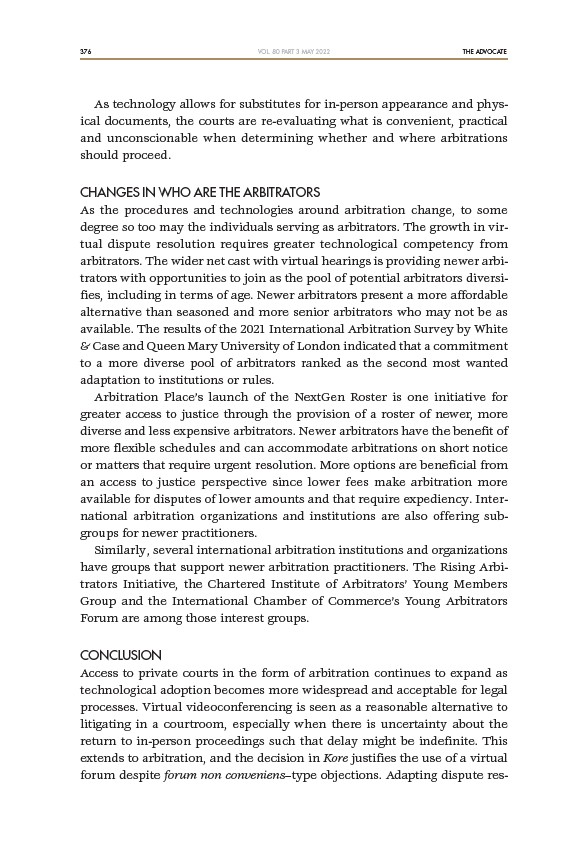
376 THE ADVOCATE
VOL. 80 PART 3 MAY 2022
As technology allows for substitutes for in-person appearance and physical
documents, the courts are re-evaluating what is convenient, practical
and unconscionable when determining whether and where arbitrations
should proceed.
CHANGES IN WHO ARE THE ARBITRATORS
As the procedures and technologies around arbitration change, to some
degree so too may the individuals serving as arbitrators. The growth in virtual
dispute resolution requires greater technological competency from
arbitrators. The wider net cast with virtual hearings is providing newer arbitrators
with opportunities to join as the pool of potential arbitrators diversifies,
including in terms of age. Newer arbitrators present a more affordable
alternative than seasoned and more senior arbitrators who may not be as
available. The results of the 2021 International Arbitration Survey by White
& Case and Queen Mary University of London indicated that a commitment
to a more diverse pool of arbitrators ranked as the second most wanted
adaptation to institutions or rules.
Arbitration Place’s launch of the NextGen Roster is one initiative for
greater access to justice through the provision of a roster of newer, more
diverse and less expensive arbitrators. Newer arbitrators have the benefit of
more flexible schedules and can accommodate arbitrations on short notice
or matters that require urgent resolution. More options are beneficial from
an access to justice perspective since lower fees make arbitration more
available for disputes of lower amounts and that require expediency. International
arbitration organizations and institutions are also offering subgroups
for newer practitioners.
Similarly, several international arbitration institutions and organizations
have groups that support newer arbitration practitioners. The Rising Arbitrators
Initiative, the Chartered Institute of Arbitrators’ Young Members
Group and the International Chamber of Commerce’s Young Arbitrators
Forum are among those interest groups.
CONCLUSION
Access to private courts in the form of arbitration continues to expand as
technological adoption becomes more widespread and acceptable for legal
processes. Virtual videoconferencing is seen as a reasonable alternative to
litigating in a courtroom, especially when there is uncertainty about the
return to in-person proceedings such that delay might be indefinite. This
extends to arbitration, and the decision in Kore justifies the use of a virtual
forum despite forum non conveniens–type objections. Adapting dispute res-